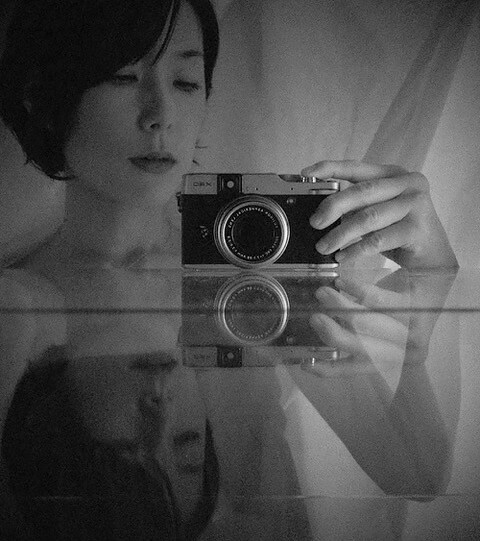Miho Kajioka was born February 21st, 1973 in Japan and studied at Concordia University and the San Francisco Art institute in the 1990s. Kajioka's artistic practice is in principal snapshot based; she carries her camera everywhere and intuitively takes photos of whatever she finds interesting. These collected images serve as the basic material for her work in the darkroom where she creates her poetic and suggestive image-objects through elaborate, alternative printing methods. Kajioka regards herself more as a painter/drawer than as a photographer. She feels that photographic techniques help her to create works that fully express her artistic vision. Her images evoke a sense of mystery in her constant search for beauty. The focused, creative and respectful way in which she uses the medium of photography to create her works seems to fit in the tradition of Japanese art that is characterized by the specifically Japanese sense of beauty: wabi sabi. Wabi has been described as 'serene attention to simple things' and sabi as 'beauty acquired through the patina of time'. The artist regards herself as a maker of objects rather than a maker of photographs, using moments of her everday life as both inspiration and material.
Source: Peter Fetterman Gallery
Miho Kajioka (b. 1973, Japan, lives in Kyoto) studied fine art in the United States and Canada and started her career as a journalist in her native country Japan. It was after the 2011 earthquake and tsunami that Kajioka was reconnected to her photographic art. Two months after the disaster, while reporting in the coastal city of Kamaishi, where over 800 people died, she found roses blooming beside a blasted building. That mixture of grace and ruin made her think of a Japanese poem:
In the spring, cherry blossoms,
In the summer the cuckoo,
In autumn the moon, and in
Winter the snow, clear, cold.
Written by the Zen monk Dogen, the poem describes the fleeting, fragile beauty of the changing seasons. The roses Kajioka saw in Kamaishi bloomed simply because it was spring. That beautiful and uncomplicated statement, made by roses in the midst of ruin, impressed her, and returned her to photography.
The photos presented, span Kajioka's adulthood, including pictures she took while living abroad, as well as scenes she captured in Japan after the disaster. The little pictures of a flower, or a running boy, are scenes from daily life, as it is. These fragments of her life, from various periods and against changing backdrops, are not so different from each other, and the differences that remain aren't important. Happiness, sadness, beauty and tragedy only exist in our minds. Things are just as they are.
Since 2013 Kajioka's work has been exhibited in France, the Netherlands, Colombia, the United Kingdom, Italy, Germany and Spain.
Source: IBASHO
Exhibitions
2020
tanzaku, The Photographers' Gallery Print Sales (February 7 to March 22)
2019
time travel (duo exhibition with Rens Horn), de ketelfactory, Schiedam, the Netherlands (September 28 to December 22)
And, where did the peacocks go?, International Photo Festival InCadaqués, Cadaqués, Spain (September 20 to 29)
And, where did the peacocks go?, Kunstenfestival Watou, Watou, Belgium (June 29 to September 1)
2018 (all solo)
So it goes, IBASHO Gallery, Antwerp, Belgium (September 9 to November 4, 2018)
So it goes, Caroline O'Breen Gallery, Amsterdam, Netherland (September 8 to October 13, 2018)
Half a dozen, Residency Program, Lisbon, Portugal (May 24 to August 31, 2018)
Unfinished spaces, The Photographers' Gallery, Print Sales, London, UK (Feb 23 to April 14)
2017
And, where did the peacocks go?, Corden Potts Gallery, San Francisco, US (March 23 to April 29)
2016
And, where did the peacocks go?, Galerie VU', Paris, France (June 8 to September 2 – Solo)
Et, où les paons sont-ils allés?, Festival La Gacilly Photo, France (June 3 to September 30)
Grace and Ruin, SeeLevel Gallery, Amsterdam, Netherland
And, where did the peacocks go?, Central Colombo Americano, Bogota, Colombia
2015
Renaissance Photography Prize, Getty Images Gallery, London, UK (Group)
And, did the peacocks go?, ARTBO, Bogota, Colombia (Solo)
And, where did the peacocks go?, Twenty 14 Contemporary, Milan, Italy (Solo)
UNREAL, M2 Gallery, Sydney, Australia (Group)
2014
LAYERS, Microprisma, Rome, Italy (Solo)
as it is, Fotografika Galerie, Gland, Switzerland (Solo)
Balade(s) Parcours Photographique, Galerie Le Neuf, Lodève, France (Group)
Boutographies, Montpellier, France (Group)
Catching tails, Linke, Milan, (Group)
2013
As It is, Centro Italiano della Fotografia d'Autore, Bibbiena, Italy (Group)
Reality and Emotion, Valid Foto BCN Gallery, Barcelona (Group)
Galleries
IBASHO, Antwerp, Belgium
The Photographers' Gallery, Print Sales, London, United Kingdom
Galerie Caroline o'Breen, Amsterdam, the Netherlands
Ira Stehmann Fine Art, Munich, Germany
Bildhalle, Zürich, Swizterland
Polka Galerie, Paris, France
Twenty14 Contemporary, Milan, Italy
Peter Fetterman Gallery, Santa Monica, United States
